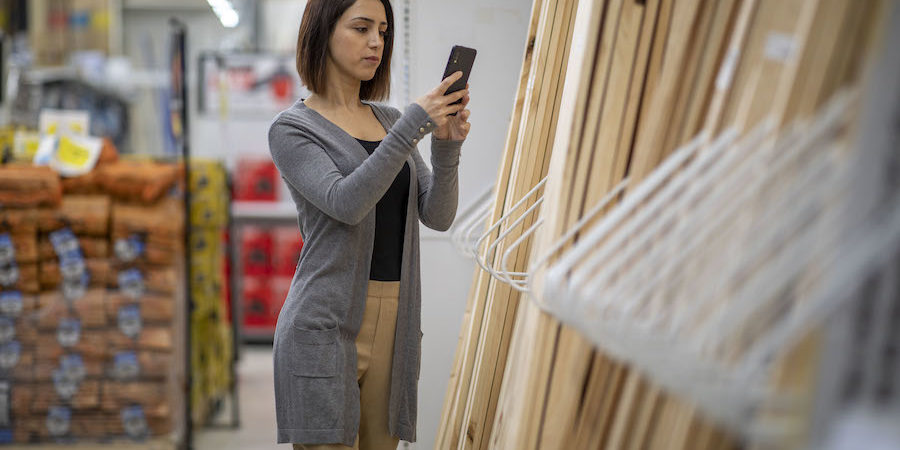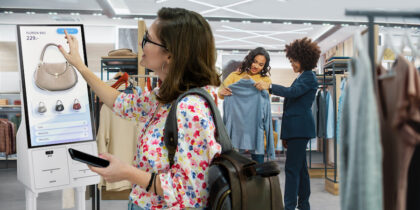Smartphones are quickly proving to be the key to an elevated, data-fueled shopping experience. Faster than point of sale (POS) terminals and more versatile than a dedicated scanner, smartphones can bring customers answers in a single bound.
Expert advice and immediate gratification are the two biggest reasons customers go to stores. When they get there, they don’t want to have to download the store’s app for help or have to grab a store-owned scanner to locate and scan their own products. They want informed help from a knowledgeable associate. According to TimeTrade, when customers know store associates are collaborating to help them on mobile devices such as tablets and smartphones, 57 percent of shoppers felt they received prompt, personal service, and 88 percent were somewhat or extremely likely to buy as a result.
Retailers can achieve the same high sales growth and customer satisfaction that early adopters are already achieving by following these six simple steps:
1. Design Your Own Customer Experience
Every retail brand is unique, and the shopping experience should reflect that. A great mobile program starts with identifying customer journeys and defining how those can be turbo-charged with mobile. Will customers be looking for associates to provide fast access to extended inventory? Rich, personalized content and promotions based on their search and purchase history? Do they want to get in and out quickly? These answers help prioritize mobile app rollout and guide device selection. Samsung devices support customer experience innovation with a device ecosystem and customizable platform that help retail associates run complex cloud-based applications to deliver information quickly.
2. Choose the Right Device for the Job
Today’s mobile devices vary widely. The Samsung device portfolio, for instance, includes not only a wide variety of smartphones, tablets and wearables but also varied screen sizes, processors, connectivity options, battery life, rugged options and more. For example, a high-touch format such as a furniture store may call for a clienteling solution in which the associate and customer can share a screen and the customer can sign off on purchase, delivery and service documents — making a Galaxy Tab Active Pro tablet with an S Pen the ideal choice. On the other hand, an associate picking orders for click-and-collect and processing mobile checkout may be best served by the Galaxy XCover Pro. To pick the right device, use this quick assessment for personalized recommendations.
3. Ensure Device Security
Retail mobile devices have to access a lot of sensitive material, like pricing data and payment gateways. Protecting that data is critical. Every Samsung device is built on the Knox platform, which solidifies security from the chip up. Knox uses a process architecture known as TrustZone, which isolates sensitive computations and tightly defines processes in order to prevent malicious applications from taking root. Samsung devices continuously self-scan, looking for inconsistencies that suggest an attack and protecting the device from their impact. Advanced fingerprint authentication ensures that only the authorized user can access the phone.
4. Preconfigure at Scale
Issuing mobile devices is a large-scale project that promises big dividends. To make rollout and ongoing enrollment flow smoothly, retailers need tools to manage and automate the process, minimizing touches while ensuring every device arrives at the store ready to go, right out of the box. Samsung Knox Configure allows retail IT to custom configure a whole fleet of devices with just the apps and settings that associates need to get the job done, so the investment can start paying off fast.
Transform Retail Associate Performance
Get your free guide to empowering retail associates with mobile devices and data. Download Now
5. Manage the Fleet
As you commit to mobile technology, it’s important to adopt best practices for device management. With Knox Mobile Enrollment, you can add thousands of devices to your enterprise at once rather than enrolling each one manually. Continuous management of the device fleet can be automated at a granular level with a mobile device management (MDM) solution such as Knox Manage, which allows IT managers to remotely manage all devices simultaneously, including whitelisting/blocklisting certain applications.
With these tools, retailers can manage device security and track important factors like OS status, ensuring that store mobile devices are always operating at the top of their game. And if a device goes missing, IT can remotely locate, lock and wipe it to ensure any sensitive data remains protected from unauthorized users.
6. Train and Support Associates
As routine store-floor tasks become more automated, many store associates will see their jobs evolve. New tasks will include picking items for click-and-collect, processing transactions away from a cash/wrap and, above all, working more closely with customers. Intuitive devices like the Samsung Galaxy mobile portfolio, together with quality training and support, are key to smoothing the transition and bringing new associates up to speed. Walmart, for example, is rolling out an associate-designed mobile app that simulates potential in-store situations to help train new employees.
Savvy retailers have caught on to the essential role that in-store mobile must play in retail’s digital transformation. RSR found that 65 percent of retail “winners” (versus 38 percent of all others) say there will be more selling activity in stores over the next two years. IHL discovered that retail leaders are empowering associates with better tools 71 percent faster than average retailers. With a well-planned mobile program, retailers can quickly get on board with this transformation, laying the groundwork to stand out in the world of next gen, data-fueled retail.
Learn how you can improve retail associate performance with data and mobile devices, or find out more about the rugged new Galaxy XCover Pro.









